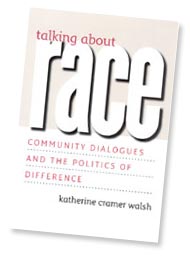New book analyzes candid community conversations on race
Katherine Cramer Walsh woke up one morning seven years ago to hear a radio advertisement promoting a community-based conversation about race in Madison.

At the time, Walsh was skeptical. At first blush, she pegged the discussions — called the Study Circles on Race — as a feel-good exercise in one of America’s more liberal-thinking communities.
Although Walsh was doubtful, she was curious, too.
A University of Wisconsin–Madison political science professor whose specialty is civic dialogue on politics, Walsh decided to take a deeper look — one that turned her original judgment on its head and led to her just-released book from the University of Chicago Press, "Talking About Race: Community Dialogues and the Politics of Difference."
"This seemed, at first, to be a creative way of avoiding doing anything about race relations," Walsh says. "But I’ve become kind of enamored of the process. People in the conversations were very sincere and pretty intense, often against the wishes of the facilitators."
People generally resort to two paths to reconcile problems about race, either by focusing on unity and similarity or by stressing the importance of multiculturalism, she says.
"These conversations, I thought, would be very multicultural and have a limited use because polls have shown that doesn’t resonate with the American public," she says. "Instead, participants in these discussions did this complex balancing of unity and difference. "
Walsh identified 400 cities in 46 states that engaged in these types of discussions, and her research zeroed in on five programs — three in Wisconsin and two in Illinois.
The unity theme was often the starting point for the discussions, but they quickly took off in other directions when people discussed their differences.
"In introducing themselves, almost everyone would say, ‘I’m doing this because I want to get beyond race,’ or ‘I want to see people as people,’" she says. "Then, people of color would offer up these stories about life in the community. That would make people stop and say, ‘Maybe we don’t all experience things in the same way and maybe we do have a problem here.’"
Anecdotes from daily life were powerful tools in stimulating the discussions, Walsh says.
"Light bulbs go on all over the place," Walsh says. "People would say, ‘I had no idea that my Japanese-American neighbor was followed through the grocery store every time she shops.’ And people of color had light bulbs go off, too. They said they had no idea that their white neighbors had no idea about the experiences they faced."
At one of the discussions a black couple talked about how their friends in Milwaukee were reluctant to come to visit them in a predominantly white city, fearing for their personal safety. A white city agency official attending the session — one who lived in the community for 25 years — was astounded, Walsh says.
"I have to believe that kind of awareness has had some impact on the way he does his job," she adds.
The discussions were often blunt and honest.
"People would engage in these difficult conversations and say things like, ‘What the heck do I call you? Black? African American? The N-word?’ It drew some chuckles, but it sparked a fascinating hour-long discussion about how to ask and when you should ask."
Walsh says that while the sessions in some communities may have been created to be a Band-Aid for racial problems, people who participated saw them as important avenues for the exchange of views about race.
"There are so many reasons to believe that this sort of thing is baloney, but people on the front lines swear by this," Walsh says. "Simply talking to one another is something that needs to happen and can generate lots of positive action. The value of people listening to one another can’t be overestimated."
